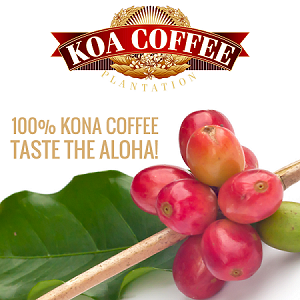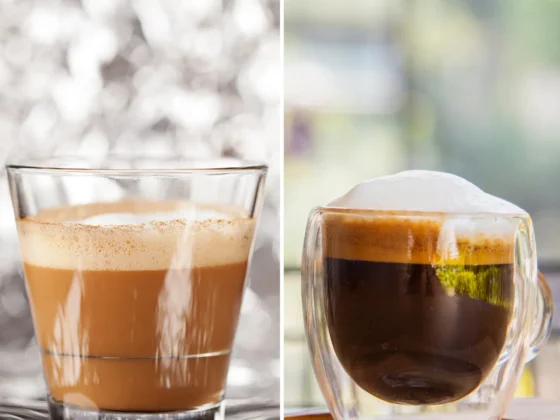Embarking on a journey through the rich landscape of espresso-based coffees, aficionados often find themselves at a crossroads: cortado vs latte. Each offers a unique experience steeped in tradition, culture, and personalization. This article delves into the heart of what sets these two popular beverages apart, from the minimalist elegance of the cortado to the customizable canvas of the latte. As we dissect their origins, serving styles, and the multitude of variations that cater to every palate, we provide coffee enthusiasts with the insights needed to make that perfect choice.
Whether it’s understanding the precise milk-to-espresso ratio that defines a cortado or exploring the latte’s potential for flavor infusions and artistic expression, this exploration is tailored to guide you through the nuances and complexities of these beloved drinks. So, as we pour over the details, prepare to discover which coffee creation aligns with your taste and lifestyle.
Skip the reading and opt for the article’s audio rendition below.
- Introduction & Key Differences
- https://app.mysoundwise.com/tracks/16995764141486260e.mp3
- What is a Cortado?
- https://app.mysoundwise.com/tracks/16995765248683167e.mp3
- What is a Latte?
- https://app.mysoundwise.com/tracks/16995765584027102e.mp3
- Flavor Profile and Taste
- https://app.mysoundwise.com/tracks/16995765888344734e.mp3
- Ingredients and Preparation
- https://app.mysoundwise.com/tracks/16995766302177688e.mp3
- Serving Styles and Variations
- https://app.mysoundwise.com/tracks/16995766667715676e.mp3
- When to Choose Cortado or Latte
- https://app.mysoundwise.com/tracks/16995767042020647e.mp3
- The Origins and History
- https://app.mysoundwise.com/tracks/16995767393498342e.mp3
- Conclusion & FAQs
- https://app.mysoundwise.com/tracks/16995767779126082e.mp3
Latte vs Cortado: Key Differences
- Volume and Milk Ratio: A cortado balances espresso with an equal amount of milk in a smaller glass, emphasizing the espresso’s flavor. A latte combines a shot of espresso with more steamed milk in a larger cup for a milder taste.
- Texture and Foam: Cortado has minimal foam, offering a smooth espresso-milk blend, while a latte features a thick foam layer and a silkier texture from more milk.
- Serving Style: Cortados are served simply to highlight the coffee, whereas lattes are often customized with various flavors and decorative foam.
- Taste Intensity: The cortado presents a pronounced espresso taste, whereas the latte has a more subdued coffee flavor, allowing the creamy milk to dominate.
- Cultural Origins and Variations: The cortado stays true to its Spanish origins, enjoyed with minimal variation, while the latte has been adapted into numerous forms globally, from the classic latte macchiato to various flavored versions.
What is a Cortado?
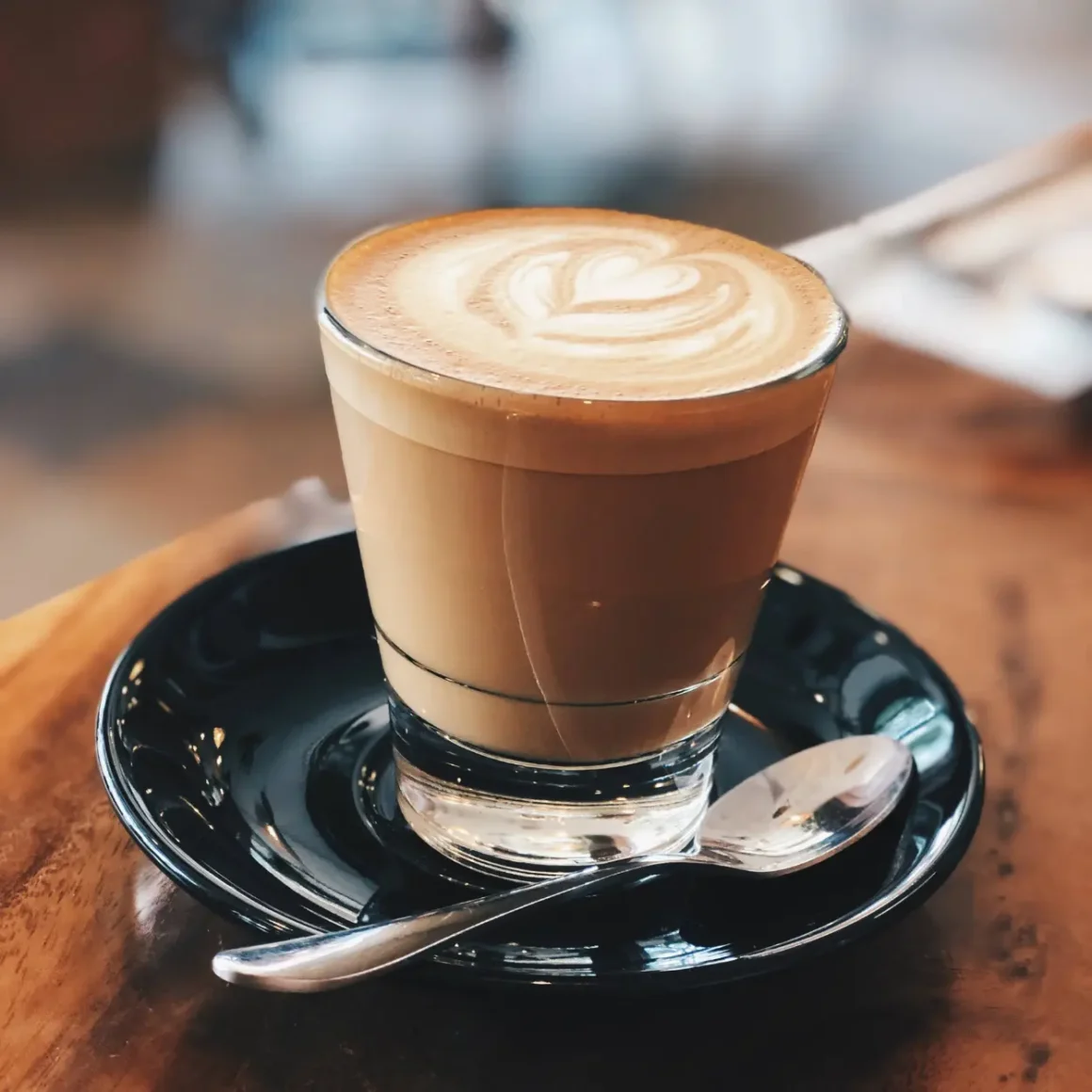
A cortado, with roots deeply entrenched in Spanish coffee culture, is a harmonious marriage of bold espresso and a modest measure of steam-heated milk. The purpose of this fusion is not to overwhelm but to subtly soften the intensity of the espresso. This delicate balance is achieved through careful preparation, which we will explore.
- Espresso Base: At the heart of a cortado lies a perfectly pulled shot of espresso, rich and full-bodied, serving as the robust foundation of the drink.
- Steamed Milk: Unlike other milk-based coffee beverages, the cortado utilizes a relatively small amount of milk. This milk is steam-heated, creating a light, creamy texture that complements, rather than dilutes, the espresso.
- Cortado Meaning: The term itself embodies the essence of the drink. “Cortado” translates to “cut” in Spanish, a direct reference to the milk’s role in cutting through the espresso’s boldness, softening its bite without masking its natural flavors. (1)
- Serving Tradition: Traditionally, this beverage is served in a small glass, which not only enhances its visual appeal but also maintains the coffee’s temperature, ensuring that every sip is as intended by the barista.
The cortado stands as a testament to minimalist perfection in the coffee world. It’s crafted for those who seek the powerful embrace of espresso with just a whisper of milk to smooth the edges. When you opt for a cortado, you’re not just choosing a coffee; you’re selecting an experience that hails from tradition, perfected by time and served in a manner that is both simple and profound.
What is a Latte?
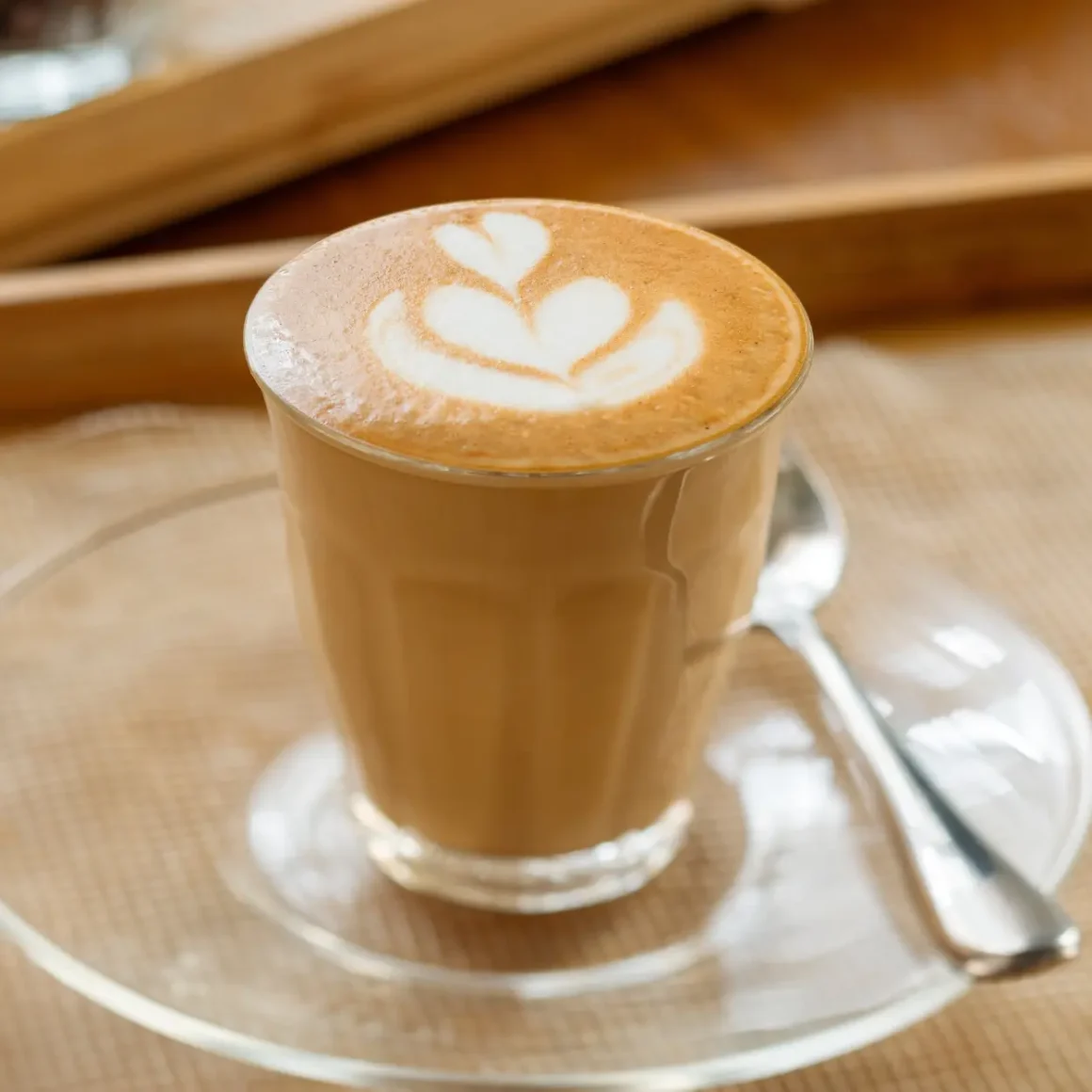
The cafe latte is an emblematic representation of how Italian coffee artistry has infused itself into the fabric of global coffee culture. This beloved drink stands out for its creamy texture and artful balance, offering a soothing, yet invigorating, coffee experience. The preparation of a latte involves a choreographed dance between three key components, each bringing its character to the cup.
- Espresso Foundation: It all begins with the espresso – a concentrated shot that forms the robust base of the latte, imparting deep coffee notes and a rich crema.
- Steamed Milk: Next, heated milk is poured in, which has been warmed and textured to the perfect temperature, introducing a velvety smoothness to the drink.
- Milk Froth: On the surface lies a light layer of froth, a crown of airy milk that adds a final touch of luxury and acts as a canvas for latte art.
- Italian Roots: “Latte” in Italian directly translates to “milk,” signifying the pivotal role of milk in transforming the espresso into a gentler, more approachable beverage. (2)
- Volume and Texture: Unlike its cortado counterpart, the latte is served in a larger cup, accommodating the generous pour of milk that defines its volume and texture.
Choosing a cafe latte means indulging in a coffee that is as much a treat for the palate as it is for the eyes. It’s a drink for those who appreciate the subtlety of coffee harmonized with the comforting warmth of milk. Whether you’re starting your morning or taking a moment to relax, a well-crafted latte stands as a testament to coffee’s versatile appeal.
Cortado vs Latte: Flavor Profile and Taste

When it comes to the realm of espresso beverages, flavor profile, and taste are paramount in distinguishing one coffee experience from another. The interplay of coffee and milk, the temperature at which they are combined, and the specific ratios all contribute to a distinctive taste that can appeal to a range of palates. Two notable contenders in this flavorful lineup are the cortado and the latte, each boasting a unique sensory profile.
Cortado: Bold and Balanced
The cortado emerges as a beacon of boldness in the espresso-based family, striking a harmonious balance between the rich zest of coffee and the soothing quality of milk.
- Espresso Dominance: The cortado’s essence lies in the pronounced presence of espresso, which commands the flavor with its potent and intricate notes.
- Milk’s Mellowing Effect: Steamed milk in just the right measure ‘cuts’ through the espresso’s bitterness, softening it to create a cohesive and palatable beverage.
- Creamy Consistency: This fusion results in a beverage that offers a creamy mouthfeel, a nod to the milk’s steamed quality, without overpowering the coffee’s robust character.
Conclusively, the cortado offers a tasting experience that is rich and textured, a perfect choice for those seeking an assertive coffee flavor complemented by the subtlety of milk, distinct from the latte vs cortado paradigm where the latter leans towards a milkier profile.
Latte: Creamy and Mild
In contrast, the latte caters to those who revel in a creamier, more mellow coffee encounter, where milk is not just an accompaniment but a key player.
- Milk-Forward Flavor: The latte charms with a taste profile that tips the scales towards the sweeter, silken qualities of milk, harmoniously blended with the espresso base.
- Velvety Texture: With a substantial portion of steamed milk capped with a frothy layer, the latte’s body is voluptuously creamy, offering a soft embrace to the palate.
- Gentle Espresso Undertones: The espresso in a latte serves as a foundation, delivering a necessary coffee depth that is inviting rather than overwhelming.
In essence, the latte is the epitome of a comforting beverage, its creamy indulgence presenting a softer side of coffee, making it a popular choice for those who prefer their coffee experience less intense and more soothing than what a cortado might offer.
Aroma and Aftertaste
The sensory journey of coffee drinking extends beyond the initial flavors to include the aroma and aftertaste, both of which play critical roles in the overall enjoyment of the beverage.
- Aromatic Invitations: The first hint of a coffee’s character comes from its aroma, with cortados offering a more pronounced coffee fragrance, while lattes provide a subtler, milky sweetness to the olfactory senses.
- Lasting Impressions: Aftertaste, or the flavor that lingers post-sip, varies significantly; cortados leave a bolder, more vivid espresso aftertaste, whereas lattes tend to have a longer-lasting creamy finish that gently fades.
To sum up, the enjoyment of a cortado or a latte extends from the initial aroma to the final notes left on the palate. Each beverage, with its distinct sensory profile, caters to different tastes and preferences within the coffee community, encapsulating the essence of the latte vs cortado comparison where personal preference is the ultimate guide.
Latte and Cortado: Ingredients and Preparation
Delving into the world of espresso drinks, the mastery of ingredients and their preparation can elevate a simple coffee to an art form. The essence of both the cortado and the latte lies not just in their individual ingredients, but in the care and technique with which they are prepared. Understanding the balance and proportion of espresso to milk, the temperature of steaming, and the method of layering can turn the preparation of these beverages into a ritualistic craft.
Espresso and Milk: The Core Ingredients
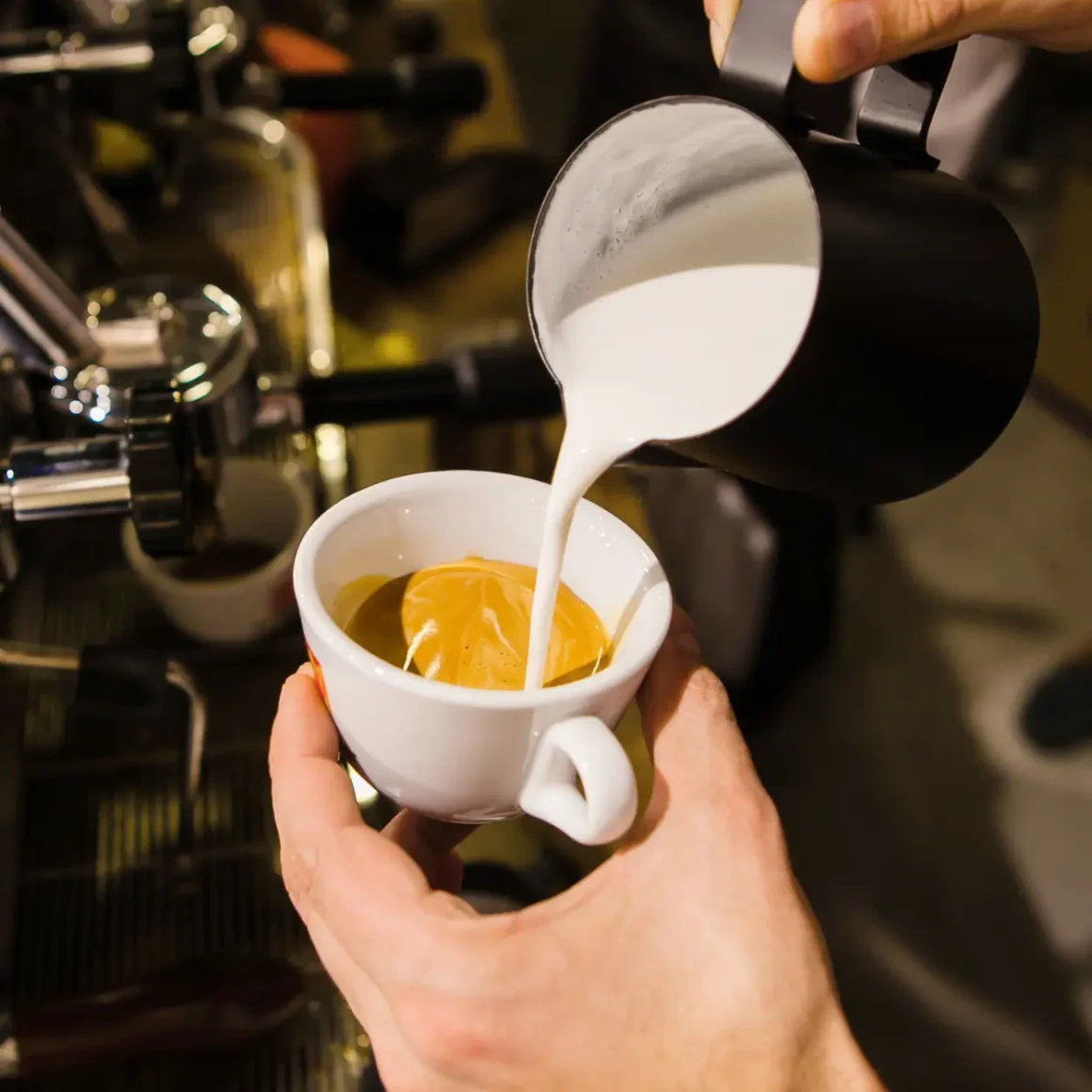
At the heart of both the cortado and the latte lies a duo of simplicity and complexity: espresso and milk.
- Espresso: This concentrated coffee serves as the foundation, its quality paramount. The choice of bean, the grind, and the extraction all influence the flavor, aroma, and body of the final drink.
- Milk: Acting as a complement to the espresso, milk adds smoothness and sweetness. The type of milk (whole, skim, plant-based) can affect the taste and texture, with whole milk providing a richer feel.
For both drinks, the espresso must be freshly brewed, and the milk steamed to the right temperature to achieve the desired froth and texture. The espresso’s bold, robust flavor combined with the milk’s creamy sweetness provides a canvas for a spectrum of coffee drinks, where precision in proportion and technique are key to perfection.
How to Make a Cortado

Embarking on the journey of how to make a cortado requires an appreciation for balance and restraint.
- Brewing the Espresso: Start by brewing a standard shot of espresso, which is typically 1 ounce (30 ml). Use an espresso machine or a Moka pot for best results.
- Steaming the Milk: While the espresso is brewing, steam the milk to between 150°F and 160°F (65°C to 70°C). Aim for a smooth, velvety texture rather than a thick foam.
- Combining the Two: Pour the steamed milk over the espresso shot gently, achieving a one-to-one ratio. The result should be a layered look with the milk blending seamlessly with the coffee.
The cortado’s allure is in its simplicity; a well-prepared cortado has a warm, creamy texture that highlights the espresso’s full-bodied flavor without overpowering it. It is a celebration of coffee and milk in their most harmonious form.
How to Make a Latte
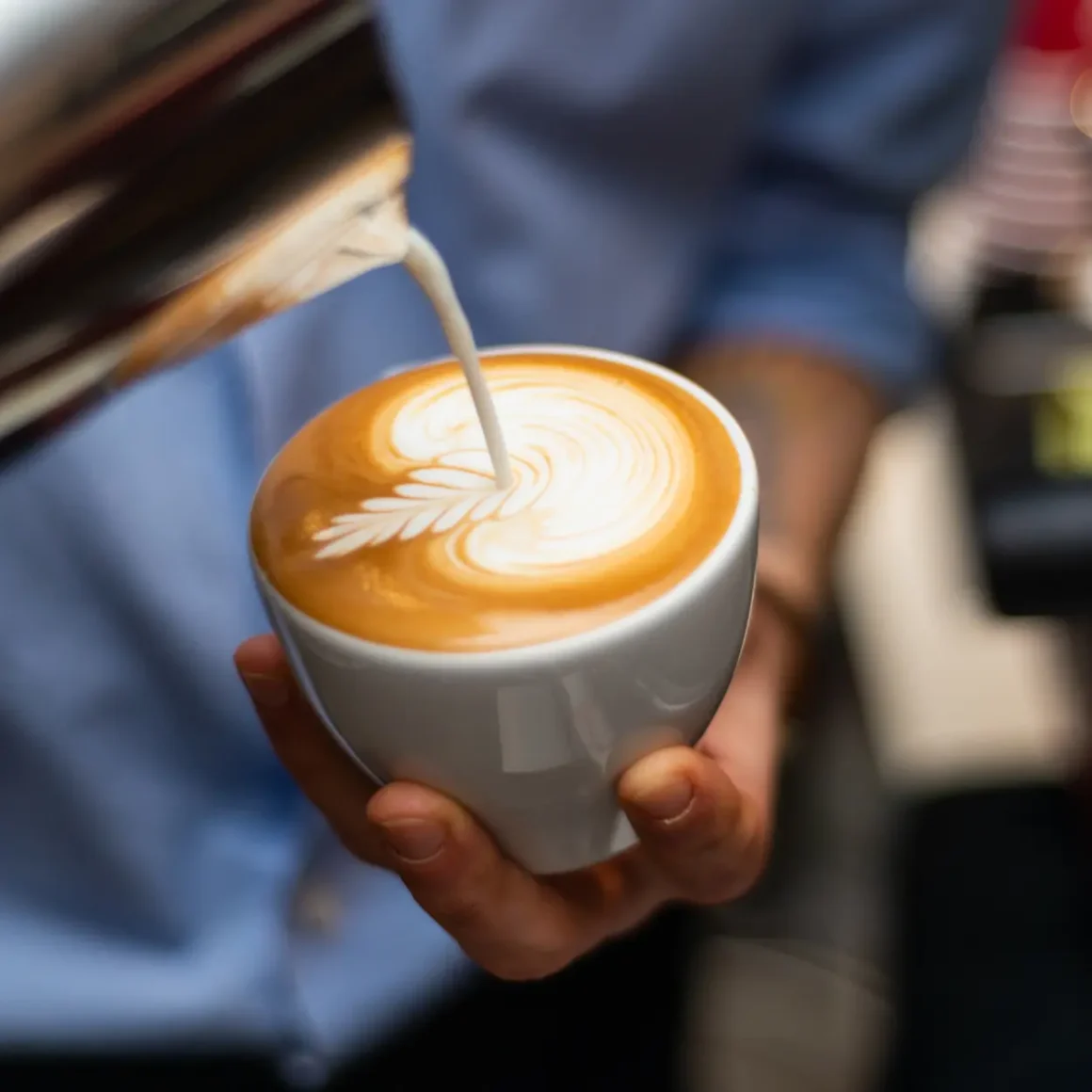
When exploring how to make a latte, one enters a realm where milk plays a starring role in the beverage’s texture and taste.
- Espresso First: As with the cortado, begin by extracting a shot of espresso. This serves as the robust base for the latte.
- More Milk, More Froth: Heat more milk than you would for a cortado, about 6 to 8 ounces (180 to 240 ml). The milk should be steamed until it is frothy with a light layer of foam, not as stiff or thick as what you would use for a cappuccino.
- Layering Liquid to Foam: Pour the steamed milk into the cup with the espresso from a low height to start with and then raise the pouring vessel higher as you finish, allowing the foam to gently sit on top of the drink.
A perfectly crafted latte offers a warm, inviting cup that’s rich in milk’s creamy sweetness, gently accented by the espresso’s depth. It’s the drink of choice for those seeking comfort in a cup, with a delicate espresso backdrop that pleases without overwhelming.
Serving Styles and Variations
The way we serve coffee is not just about the presentation; it’s a dialogue between the beverage and the drinker, enhancing the overall experience. From the minimalist to the customizable, the coffee world presents a diverse range of serving styles and variations. Let’s delve into the distinct characteristics of the cortado and latte and explore the plethora of popular variations that invite coffee lovers to tailor to their tastes.
Cortado: The Minimalist
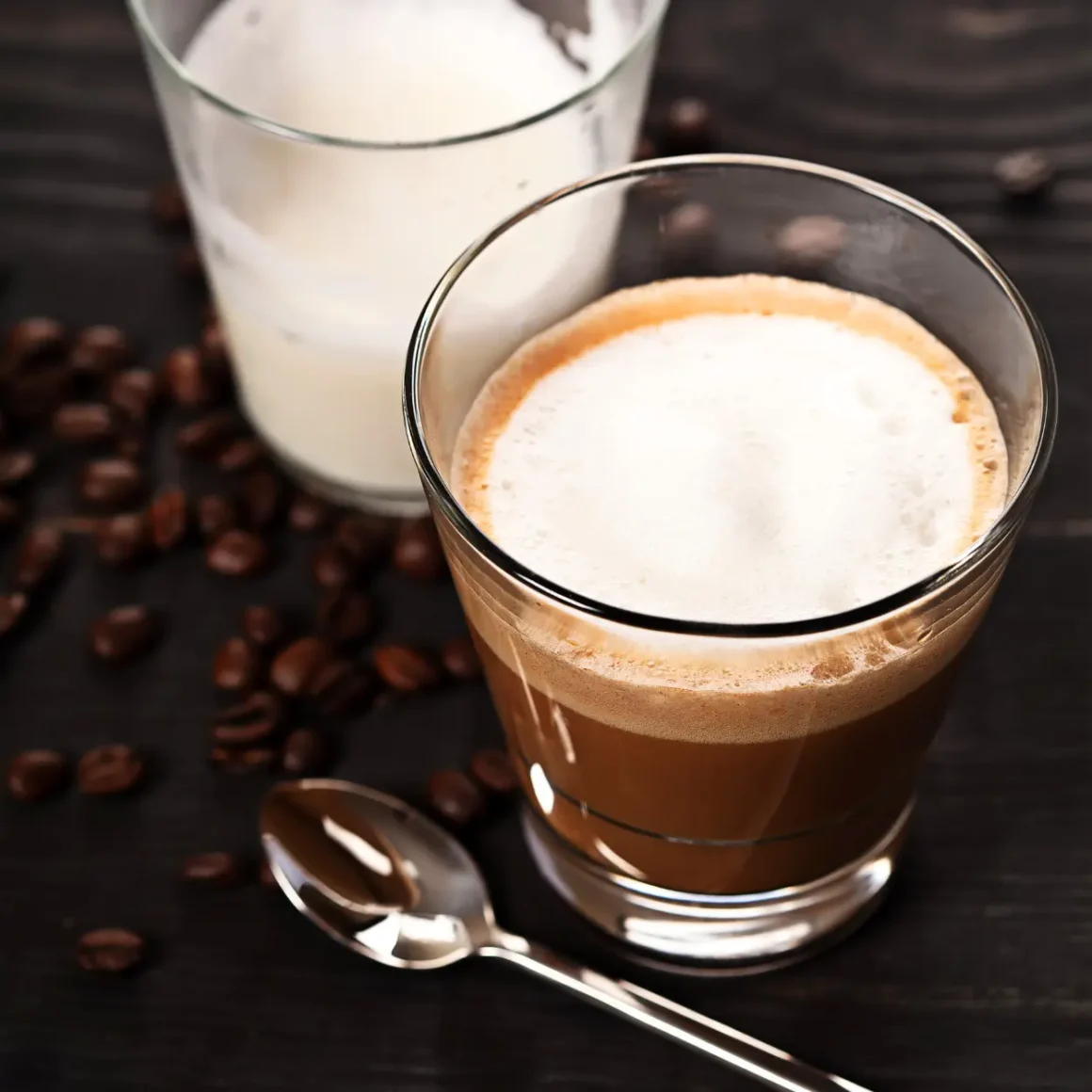
The cortado is a no-frills coffee experience that emphasizes the delicate balance between espresso and milk. In its traditional form, the cortado is a study of minimalism and balance:
- Glassware: A cortado is often served in a small, clear glass tumbler that allows the drinker to see the distinct layers of espresso and milk.
- Volume: This drink typically holds between 3 to 4 ounces, with an equal ratio of espresso to milk.
- Temperature: Served warmer than a latte, the cortado delivers a robust espresso taste tempered by the warmth and sweetness of steamed milk.
The cortado’s minimalistic approach makes it the ideal choice for coffee enthusiasts looking to enjoy a strong espresso flavor harmonized with just a touch of milk. The presentation and proportions of the cortado create a concentrated coffee experience that is both satisfying and refined.
Latte: Customization Galore

Lattes offer a canvas for creativity and personalization, allowing each individual to craft a drink that suits their palate perfectly:
- Vessels: A latte is usually presented in a larger cup or glass, providing a generous space for milk and foam.
- Foam: A latte is topped with a layer of microfoam, adding a luxurious texture and an inviting appearance.
- Customization: Lattes can be customized with various syrups, extra shots of espresso, and different kinds of milk to fit the drinker’s preference.
This customization-friendly nature of lattes means that whether you’re after something sweet, strong, or smooth, there’s a latte variation for you. It’s the perfect choice for those who appreciate a less intense coffee flavor and enjoy the act of sipping their drink slowly, relishing the velvety texture and the artful foam topping.
Popular Variations
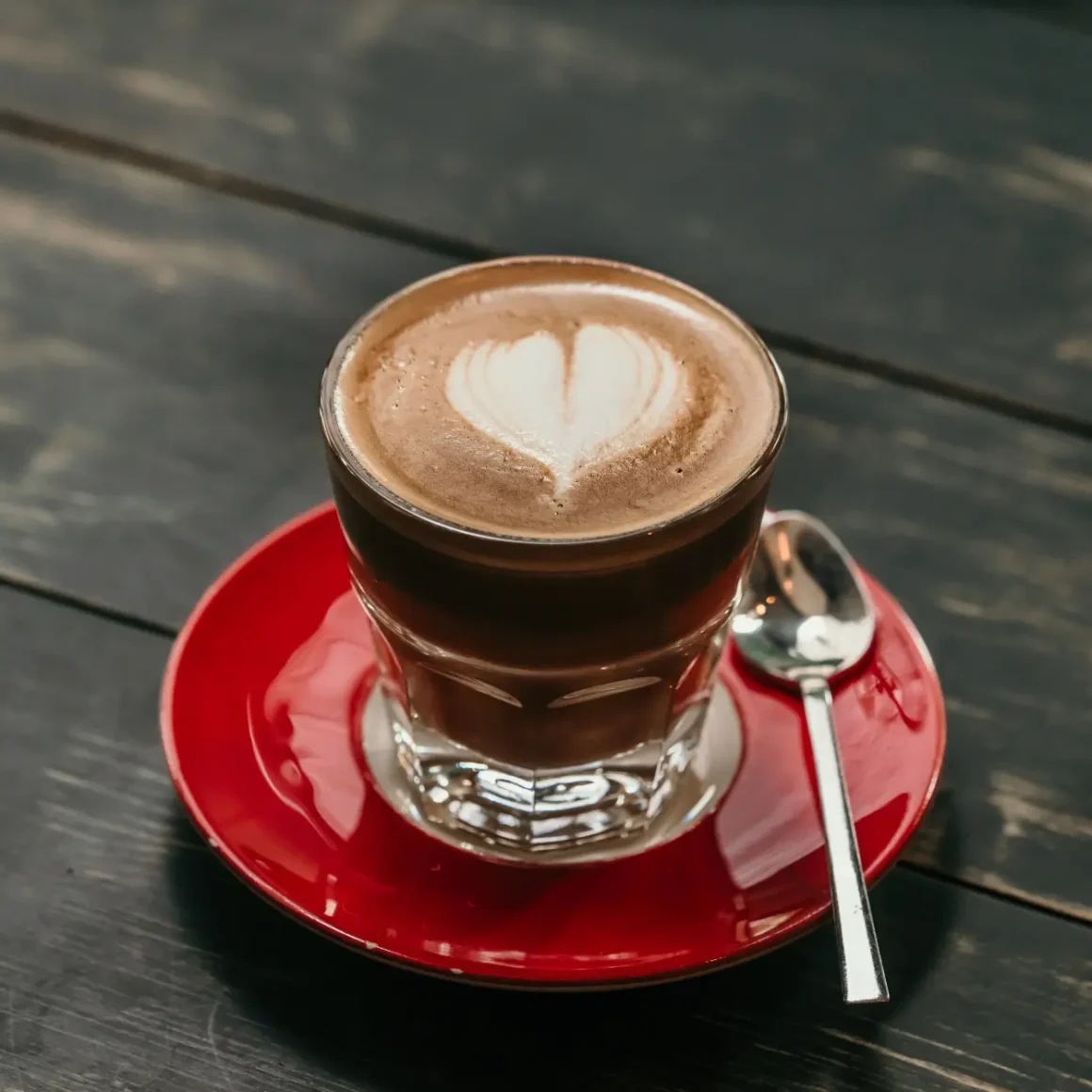
Cortado and latte stand out in the world of coffee for their remarkable flavors and varied preparations.
Cortado Variations:
- Classic Cortado: A cortado is a simple espresso-based drink made by combining equal parts of espresso and steamed milk.
- Mocha Cortado: A mocha cortado includes chocolate syrup or cocoa powder, adding a rich, chocolatey flavor to the classic cortado.
- Cinnamon Cortado: This variation incorporates a sprinkle of cinnamon, offering a subtle, spicy twist to the traditional cortado.
- Honey Cortado: Honey cortado features honey as a sweetener, providing a natural and slightly floral sweetness to the coffee and milk combination.
Latte Variations:
- Latte Macchiato: This variation emphasizes the milk, with a shot of espresso added to a glass of steamed milk, often resulting in a layered effect. (3)
- Matcha Latte: A perfect pick for those who want a break from coffee, this latte swaps espresso for matcha green tea, offering a different kind of caffeine kick.
- Pumpkin Spice Latte: A seasonal favorite, this latte combines traditional espresso and milk with rich pumpkin flavor and spices, topped with whipped cream and a sprinkle of spice.
- Chai Latte: A fusion of black tea and spices steamed with milk, this latte offers a warming and spicy alternative for those looking for complexity in their cup.
Each of these variations stands as a testament to the versatility of coffee. Whether adhering to the simple elegance of a classic cortado or indulging in the spiced complexity of a chai latte, there’s a version to suit every taste and occasion.
When to Choose a Cortado or Latte

Choosing between a cortado and a latte often comes down to personal preference, the time of day, or even the occasion. Whether you’re looking for a robust coffee flavor or a comforting, creamy drink, understanding the distinctive qualities of these two espresso-based beverages can guide your selection. Let’s delve deeper into when each of these popular coffee choices might suit you best.
Cortado for a Quick Caffeine Fix
When you need an invigorating coffee experience without the bulk of too much milk, a cortado is an excellent choice. Here’s why a cortado could be your go-to beverage:
- Intensity: With a balanced 1:1 ratio of espresso to milk, the cortado delivers a potent coffee flavor, making it ideal for those who enjoy the rich taste of espresso but with a touch of creaminess.
- Size: Due to its smaller volume, a cortado is consumed quicker than a latte, providing a rapid caffeine kick that’s perfect for a busy day.
- Digestibility: The lower milk content can be easier on the stomach, especially for those who find too much dairy unsettling. (4)
If you’re in pursuit of a coffee that’s straightforward, powerful, and won’t linger too long, the cortado wraps up this experience in a neat, small package.
Latte for a Relaxing Coffee Experience
For those moments when you desire a more indulgent and extended coffee affair, a latte stands out as the beverage of choice:
- Texture and Taste: With its generous milk content, a latte offers a milder coffee flavor and a velvety texture, which is perfect for those who prefer a less intense espresso experience.
- Versatility: Lattes are the canvas of coffee drinks, allowing for endless customizations with flavored syrups, alternative milk, and additional espresso shots to suit any taste preference.
- Leisure: The larger size of a latte makes it a drink meant to be savored, suitable for relaxed mornings, catching up with friends, or as a warm companion for solitary reflection.
When the craving for a cozy and soothing beverage arises, a latte provides a comforting embrace with its steamy, frothy goodness.
Pairing Coffee with Foods
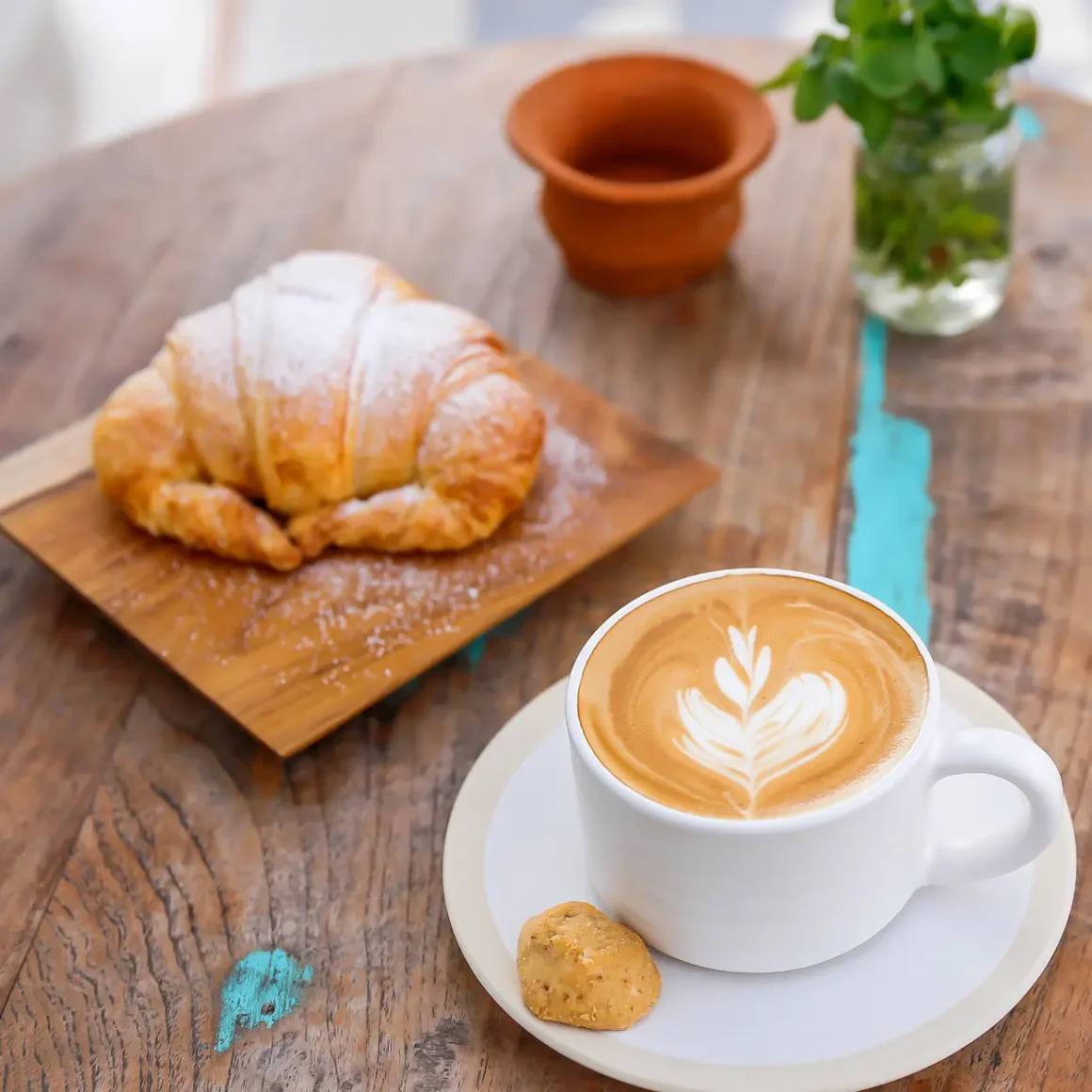
Beyond the individual characteristics of cortados and lattes, considering what foods to pair with your coffee can elevate your experience. Each coffee type can complement different kinds of foods:
Cortado Pairings:
- Pastries: The boldness of the cortado cuts through the sweetness of pastries like croissants and danishes.
- Dark Chocolate: Enjoy a piece of dark chocolate with your cortado for a bittersweet harmony.
- Savory Breakfasts: The strong coffee flavor of cortado balances well with savory breakfast items like omelets or avocado toast.
Pairing a cortado with the right foods can transform a simple coffee break into a rich sensory delight.
Latte Pairings:
- Sweet Treats: The sweetness of a latte complements desserts like cakes, cookies, or sweet pies.
- Fruit: Try a latte with a side of fruit for a refreshing contrast.
- Hearty Brunch Items: The smoothness of a latte pairs beautifully with hearty brunch dishes like pancakes or quiches.
versatility of a latte in food pairings makes it not just a drink, but a part of a meal, enhancing both the coffee and the culinary experience.
Choosing between a cortado and a latte can be influenced by your mood, taste preference, or the food you wish to pair with your coffee. Each has its unique appeal and appropriate context, enriching your coffee repertoire and delighting your palate in different ways.
Cortado & Latte: The Origins and History
The journey of espresso-based drinks like cortado coffee and cafe latte is as rich and complex as the flavors they present. From the robust terrains of the Iberian Peninsula to the bustling streets of Italy, these beverages have carved their path through history, intertwining with culture, tradition, and innovation to become the beloved coffee classics they are today.
Cortado’s Influence Beyond Spain

The cortado, a balanced symphony of espresso and warm milk, has its genesis in the Iberian Peninsula. The name itself is derived from the act of ‘cutting’ the espresso’s intensity with milk. Here’s how the cortado has left its mark beyond its Spanish origins:
- Global Spread: While maintaining its essence, the cortado has been embraced across different cultures, each adding a unique twist to this Spanish classic.
- Artisanal Appreciation: In the United States, the Gibraltar variation has seen a rise in popularity, particularly within specialty coffee shops.
- Cultural Adaptation: Different regions have adapted the cortado to suit local tastes, sometimes varying the milk-to-espresso ratio or the serving style, yet the heart of the cortado remains constant.
The cortado’s journey is one of cultural adaptation, where it has been respected for its strong coffee flavor while being versatile enough to meld with varied global coffee preferences.
Latte’s Journey to Global Fame

The cafe latte’s voyage to international stardom began in the bustling cafes of Italy, crafted initially to appease the American penchant for milk-infused coffee. This indulgent blend of espresso and milk, topped with froth, became a canvas for innovation and a staple worldwide.
- Italian Genesis: The mid-1900s marked the birth of the latte in Italy, where it quickly became a cross-continental favorite.
- Starbucks’ Influence: Global coffeehouse Starbucks has been instrumental in popularizing the latte, introducing it to a worldwide audience with an array of flavors.
- Variety and Evolution: From the classic Café Latte to the sweet Caramel Latte, this drink category has expanded to include a diverse spectrum of tastes and presentations.
In essence, the cafe latte’s history is a rich narrative of cultural exchange and evolution, leading to a globally embraced coffee style that continues to inspire new iterations.
Coffee Rituals and Traditions
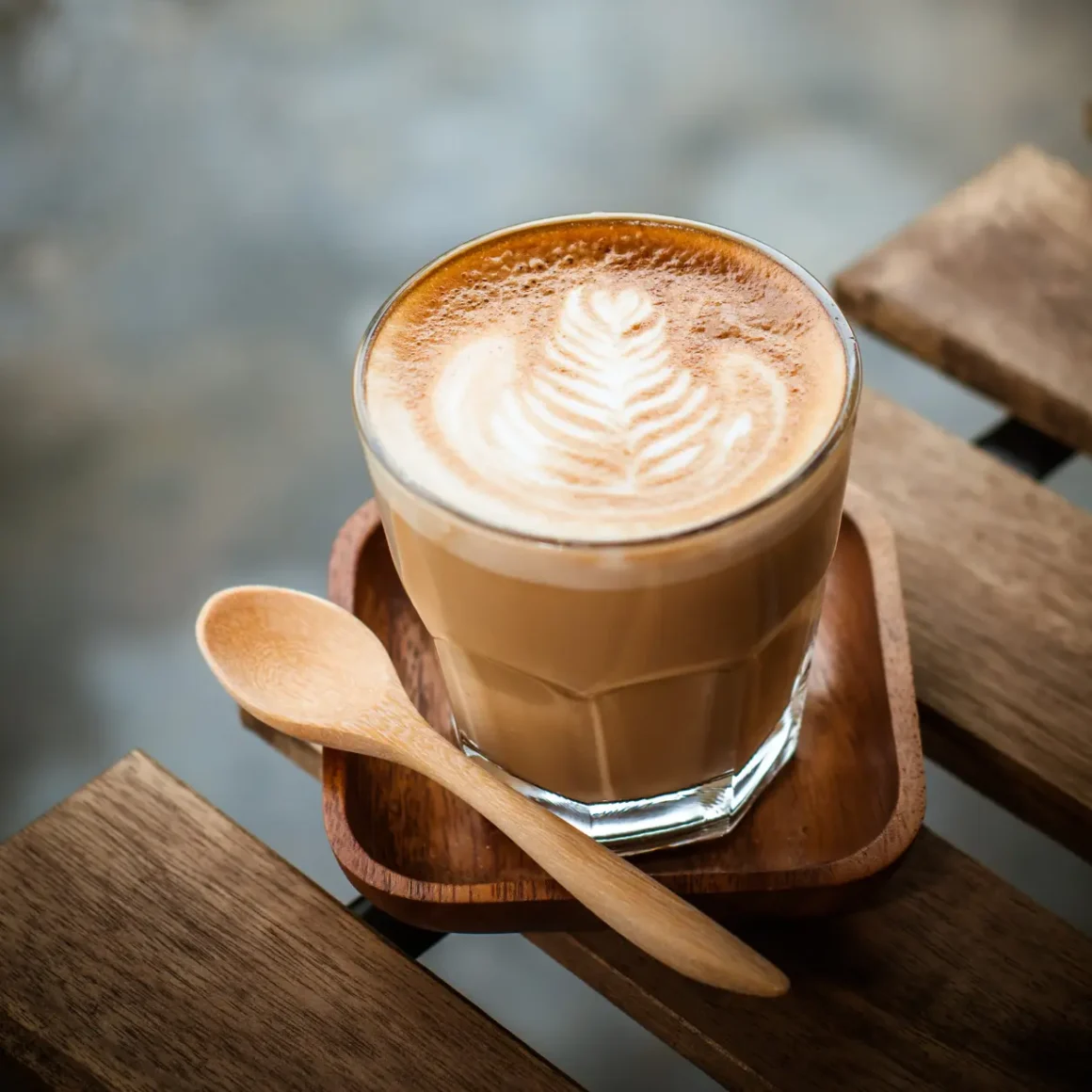
The rituals and traditions surrounding coffee consumption are as varied and rich as the drink’s history itself. From the precise construction of a cortado to the artistic creation of a latte, these practices go beyond mere preparation, embodying cultural significance and personal expression.
- Ritualistic Preparation: Each step in crafting cortado coffee or a cafe latte is steeped in tradition, from the pull of the espresso to the pour of the milk.
- Cultural Significance: These beverages carry the weight of their origins, reflecting the values and preferences of the cultures that created and embraced them.
- Personal Touch: Across the world, baristas and enthusiasts add their signature styles to these drinks, showcasing coffee’s role as a medium for creativity.
To encapsulate, whether it is the cortado’s bold simplicity or the latte’s creamy sophistication, coffee rituals, and traditions are a testament to the beverage’s enduring significance and the personal connection it fosters among its devotees.
Conclusion
In the exploration of cortado vs latte, we have ventured through the defining characteristics, variations, and customizable options of these beloved espresso-based drinks. A cortado, with its equal balance of espresso and milk, offers a minimalist approach for those who appreciate a stronger coffee flavor and a smooth texture. On the other hand, when one asks what is a latte? they find a canvas for creativity – a larger, milder beverage that welcomes a variety of flavors and textures, topped with a generous foam.
From the textured layers of a latte macchiato to the autumnal notes of a pumpkin spice latte, and from the bold simplicity of a cortado to the personalized flair of a chai latte, we’ve seen that your choice depends on personal taste preferences and the desired coffee experience. Whether you favor the rich, robust essence of a cortado or the creamy indulgence of a latte, each has its unique appeal and place in the coffee culture. Your next coffee break is an opportunity to reflect on these nuances and choose the cup that best compliments your moment.
FAQ
What's the difference in the milk-to-espresso ratio?
A cortado typically has a 1:1 ratio of milk to espresso, while a latte has a much larger proportion of milk to espresso, often 3:1 or more.
Can I add flavors to a Cortado or Latte?
Yes, both cortados and lattes can be customized with a variety of flavors through syrups or infusions.
Are Cortado and Latte suitable for people with lactose intolerance?
Both drinks can be made with lactose-free milk or plant-based alternatives, making them suitable for those with lactose intolerance.
Which coffee drink is more popular worldwide?
The latte is more popular worldwide, known for its creamy texture and versatility in flavors and customizations.







